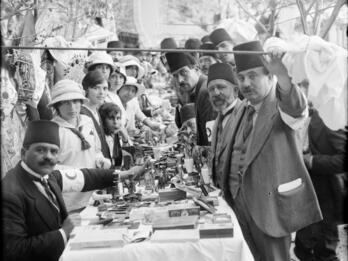The Future of American Jews
II
But a few years ago, before the outbreak of the world-wide European upheaval [World War I], no one even entertained the possibility that a center for the revelation and development of the Jewish national spirit would be established in America. There were, it is true, some individuals among the leaders of the Jewish intelligentsia who yearned with all their hearts for the creation and formation of such a center—they were known as “patriots.” However, even these patriots spoke of an additional center, a parallel center. That America would join the ranks of Jewish leadership—even the most adamant and patriotic supporters of America could not have dreamed of such a thing. Indeed, approximately twenty years ago, when the skies of Russian Jewry were eclipsed by dark clouds, when even the optimists lost their faith in better times, the greatest of Jewish scholars, Simon Dubnow, predicted that in the next two or three generations, the primacy of world Jewry would migrate from Eastern Europe to America. And he had every justification for expressing this view, for in those days people were leaving for America in massive droves, and one could not help but expect that the numbers would grow exponentially. But with the dawn of liberty in Russia, this view was dispelled. People realized that for the foreseeable future, the Jewish center in Europe would remain unaffected. Even in America this was the prevailing view; they knew that Eastern Europe held a treasure-trove of creative cultural forces that would be able to sustain all of diaspora Jewry.
After the Great War broke out with mighty force, the Jewish world of Eastern Europe was gripped with trembling; American Jewry trembled greatly as well. And this trembling was not merely the result of compassion; it was an instinctive trembling that went far deeper. The basis of the entire building, the entire House of Israel, was in danger, and even its most remote pillars consequently shook. When the heart trembles and shudders, the entire body shakes as well. The people’s intuition—a vigilant guardian keeping watch behind our backs, warning us of impending evil on the horizon—informed the Jews of America of the great destruction taking place across the sea, even before the official reports arrived. [ . . . ]
So, the time was ripe for the birth of the idea of national Jewish salvation among American Jewry—not only through donations to those who suffered and lacked, but also by this Jewry accepting upon itself the loftier national obligations. At this time, people began to speak loudly in the Jewish intelligentsia circles; they began to discuss the emergence of a Jewish cultural center in America. And it was a great help that due to the war, America had suddenly been enriched by great creative forces arriving from across the sea. Gold from all the treasuries of Europe flowed into American banks, and from every Jewish center in Europe and the Land of Israel, the enlightened Jews flocked to America. Everyday Jewish communities were filled with life and movement. They began to speak more frequently and with greater emphasis about Jewish national goals, and they began to discuss with greater gravity, and more depth, the Jewish national problem. Hearts began to boil, and even Jewish life in America was split into two camps. Not so long ago, the national question was discussed as a distant concern, the mere echo of a dispute that animated controversies in Europe. Now it drew ever closer to the American Jew—or, and really this is the same thing—the Jewish American drew ever closer to the issue; his relationship to it was now stronger. Thus, our thoughts also draw closer to the primary question: what are the subjective conditions needed for the formation of a Jewish cultural future in America? In other words, does the heart of American Jewry have a sufficiently strong will to aspire for its own future? And if it does indeed harbor such a will in its heart, does it possess the creative powers to realize this desire—to actuate it? [ . . . ]
Two different groups, polar opposites in terms of their activity, and distinct from each other in their aspirations, goals, and desires, have taken on the role of catalyst for the development of American Jewry. On the one side is German Jewry, the stronger [of the two] from an economic perspective, and the dominant voice [of American Jewry]. On the other side, is Russian Jewry (and belonging to this group are also Polish and Galician elements): the group of workers, great in number, who are good at organizing and surviving.
German activity is manifest in two realms of Jewish public life: charity and religion. In charity and relief its activity was positive; all charitable work has something positive to it. By contrast, in the realm of religion—its activity is entirely denialist. The entire Reform movement is driven—not by the internal impetus for new religious ideas—but rather by an aspiration to integrate into its surroundings. Therefore, [this movement] has been diligent in its attempts to uproot from Judaism any mention of origins or source, any remnant of its Eastern character. The entire historical past, and everything that derives from it, is treated as something obsolete and invalid. They removed from the Jewish faith all of its folk elements. They erased all of the folk splendor, which had been bound to it from the most distant past until the very last generations. They left only the dry principles of monotheism. Thus, a rich faith was transformed into a dry religion. [ . . . ]
On the other side are the workers, whose organizations and institutions have influenced the evolution of American Jewry. Without a doubt, the Jewish workers found within themselves, like all other masses, a vital force and creative, popular powers. From the perspective of the masses, of the collective, they would not have alienated themselves from the spirit of the Jewish people. All the more so, they could not detach themselves from the people’s historical ideals. Unfortunately, their development also took crooked paths. First, they couldn’t fight simultaneously for their material existence and for their spiritual development, to create a “sequel” to their development in their former homeland [in Eastern Europe]. Second, they did not appoint leaders worthy of the title. One should not forget the prevailing spirit just thirty—or even twenty—years ago in the enlightened Jewish circles who turned their attention to social questions. One must not forget that the Bundists of our time, when compared to the first leaders of Jewish labor movements, are like rabbis in their conservatism. [ . . . ]
From both of the parties which sought to expel American Judaism—the Reform on the one side and Jewish workers on the other—their youths arise and ascend, those who grew up on the knees of the Reform teachings. And the masses rise up against the leaders of the labor movements, they who have divested themselves of nationalism; and these masses force their leaders to change their ways and to change their attitude toward the national Jewish question. The protest against Reform does not manifest in a return to a conservative [devout] Judaism. Rather, it’s in founding youth organizations for teaching the Jewish past and delving deeply into the problems of a Jewish future. Everything consigned to death and burial by the Reform movement rises up. The Jewish masses demand that Jewish forces be organized and united based on a national foundation. Everything that the leaders strove to weaken and uproot, rises up and awakens with redoubled strength.
One cannot know whither the power of the Jewish people’s resolve will reach in America; whither the creative powers of American Jewry will arrive. However, in recent years, one thing has become abundantly clear: An opportunity has been given to create a Jewish cultural future [in America], and, as time passes, it may be that its value will be no less than the cultural powers of other diasporas.
Credits
Published in: The Posen Library of Jewish Culture and Civilization, vol. 7.




